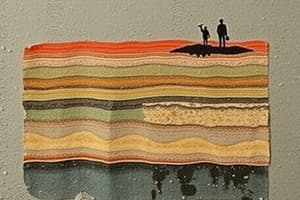Podcast
Questions and Answers
The hottest layer of the earth is the _____.
The hottest layer of the earth is the _____.
inner core
The layer of the earth that is composed of rock, yet flows due to extreme heat and pressure, is known as the _____.
The layer of the earth that is composed of rock, yet flows due to extreme heat and pressure, is known as the _____.
asthenosphere
As the submersible sets down on the ocean floor, it is resting on what layer of the earth?
As the submersible sets down on the ocean floor, it is resting on what layer of the earth?
lithosphere
The ability of solid rock to flow is called _____.
The ability of solid rock to flow is called _____.
An area where the earth's crust would be expected to be thin would be _____.
An area where the earth's crust would be expected to be thin would be _____.
The layer of the earth that is composed of large plates that interlock and move over time is the _____.
The layer of the earth that is composed of large plates that interlock and move over time is the _____.
The geosphere refers to the _____.
The geosphere refers to the _____.
Match each Earth layer with the correct description:
Match each Earth layer with the correct description:
Flashcards are hidden until you start studying
Study Notes
Layers of the Earth
- The inner core is the hottest layer, composed primarily of solid iron.
- The asthenosphere is a layer of rock within the mantle that flows due to high heat and pressure, demonstrating plasticity.
- The lithosphere is the rigid outer layer of the Earth, which includes the crust and uppermost mantle. It is composed of large tectonic plates that move over time.
- Plasticity describes the property that allows solid rock to flow under extreme conditions, crucial for plate tectonics.
- Oceanic regions, particularly under the Pacific Ocean, are expected to have thinner sections of the Earth’s crust compared to continental areas.
- The geosphere encompasses all terrestrial aspects of Earth, including the crust, mantle, and core, emphasizing interconnectedness.
- Descriptions of Earth's layers:
- Inner Core: innermost part, solid iron
- Outer Core: liquid layer surrounding the inner core, composed of iron and sulfur
- Lower Mantle: the cooler inner portion of the mantle made of solid rock, located below the upper mantle
- Upper Mantle: includes the asthenosphere, which is capable of flowing, and the lower lithosphere.
- Crust: the thin outer layer that is the planet's surface, accommodating landforms and bodies of water.
Studying That Suits You
Use AI to generate personalized quizzes and flashcards to suit your learning preferences.




